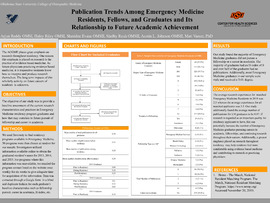| dc.contributor.author | Reddy, Arjun | |
| dc.contributor.author | Riley, Haley | |
| dc.contributor.author | Evans, Sheridan | |
| dc.contributor.author | Rauh, Shelby | |
| dc.contributor.author | Johnson, Austin L. | |
| dc.contributor.author | Vassar, Matt | |
| dc.date.accessioned | 2020-05-05T19:37:57Z | |
| dc.date.available | 2020-05-05T19:37:57Z | |
| dc.date.issued | 2020-02-28 | |
| dc.identifier | ouhd_reddy_publicationtrendsamong_2020 | |
| dc.identifier.citation | Reddy, A., Riley, H., Evans, S., Rauh, S., Johnson, A. L., & Vassar, M. (2020, Feb. 28). Publication trends among emergency medicine residents, fellows, and graduates and its relationship to future academic achievement. Poster presented at Research Day at Oklahoma State University Center for Health Sciences, Tulsa, OK. | |
| dc.identifier.uri | https://hdl.handle.net/11244/324240 | |
| dc.description.abstract | Purpose: Scholastic activity through research involvement is a fundamental aspect of a physician's training, and may have a significant influence on residency and fellowship match success. Despite this fact, little is known regarding the pursuit of academia and/or fellowships in emergency medicine graduates. In this review, we will (1) describe factors involved in academic research including peer-reviewed publications among emergency medicine residency graduates and (2) determine if a relationship exists between publication rates before, during, and after emergency medicine residency. | |
| dc.description.abstract | Methods: Using a cross-sectional study design, we analyzed the research output of emergency medicine graduates and its relationship to future academic involvement from a random sample of 50 emergency medicine programs' graduates. Data were extracted for each graduate and analyzed using STATA 15.1 and Microsoft Excel. A public protocol is available here: https://osf.io/pwa6d/. | |
| dc.description.abstract | Results: Using Doximity, we identified 238 emergency medicine residency programs of which we sampled 50. Of the 50 included programs, 6 programs were included, amounting in 154 graduates available for analysis. Of the 154 analyzed graduates, 97 (63.0%) were male, 91 (59.1%) were osteopathic graduates, and 91 (59.1%) had zero publications. Additionally, we found that 26/154 (16.9%) pursued academia and 16/164 (10.4%) pursued a fellowship, with 4/16 (25%) in medical toxicology and 4/16 (25%) in emergency medical services. The mean number of publications for each graduate was 0.87. Of the graduates with research, more research was published on average after graduation from residency (0.42) compared to before residency (0.17) and during residency (0.34). | |
| dc.description.abstract | Conclusion: While a majority of psychiatry graduate's publications were post-residency, many publications occurred during residency, with the lowest number of publications occurring pre-residency. | |
| dc.format | application/pdf | |
| dc.language | en_US | |
| dc.publisher | Oklahoma State University Center for Health Services | |
| dc.rights | The author(s) retain the copyright of have the right to deposit the item giving the Oklahoma State University Library a limited, non-exclusive right to share this material in its institutional repository. Contact Digital Resources and Discovery Services at lib-dis@okstate.edu or 405-744-9161 for the permission policy on the use, reproduction or distribution of this material. | |
| dc.title | Publication trends among emergency medicine residents, fellows, and graduates and its relationship to future academic achievement | |
| osu.filename | ouhd_reddy_publicationtrendsamong_2020.pdf | |
| dc.type.genre | Presentation | |
| dc.type.material | Text | |
| dc.subject.keywords | publication trends | |
| dc.subject.keywords | emergency medicine | |
| dc.subject.keywords | residency | |
